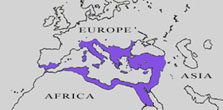
The Byzantine Empire (A.D. 324 – A.D. 1453)
The Byzantine Empire was the Eastern part of the Roman Empire that survived the fall of its Western counterpart in 476. Roman Emperor Constantine laid the foundations for this Empire in 324 when he began construction of a new Roman imperial capital called New Rome or more frequently known as Constantinople (present day Istanbul, Turkey).
After the fall of the Western Roman Empire, the Byzantine Empire assumed the mantle of old Rome, with its emperor still theoretically in control of the entire boundaries of the old Roman Empire.
With this mindset, its emperor still assumed the imperial purple, the color used to denote the royalty of the Roman Emperors. The reason for the use of purple was because the dye to make that color was extremely difficult to obtain, having come from a rare Mediterranean shellfish.
This Empire, though it would change throughout the years of its existence, continued on without interruption until May 29, 1453 when the Ottoman Turks, who used canons for the first time in warfare, breached Constantinople’s impenetrable walls and succeeded in taking over the long-lived Byzantine Empire.
Even with its fall though, the Byzantine Empire already succeeded in influencing other cultures such as Russia, which adopted many aspects of the Byzantines, even calling Moscow the “Third Rome” after the fall of “New Rome.”
And, this was all because, over 900 years before this, the Byzantine Empire was regarded as one of the most majestic Empires in the known world, having reached its apex under perhaps the greatest of all Byzantine Emperors, Flavius Petrus Sabbatius Justinianus, better known as Justinian.
Page 1 of 2 | 1 | 2 | | Next |
HER KNIGHT: Main / News / Synopsis / Cast / Crew / Gallery / Trailer / Byzantium 101 / Contact
Site Content Copyright © 2002-2025, Russem Productions, Emile Haris. All Rights Reserved.



